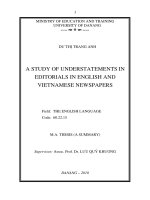politeness phenomena in english and vietnamese through using imperative mood within thang long university education environment = hiện tượng lịch sự trong tiếng anh và tiếng việt tt
Bạn đang xem bản rút gọn của tài liệu. Xem và tải ngay bản đầy đủ của tài liệu tại đây (132.29 KB, 5 trang )
VIETNAM NATIONAL UNIVERSITY, HANOI
UNIVERSITY OF LANGUAGES AND INTERNATIONAL STUDIES
FACULTY OF POST-GRADUATE STUDIES
***
NGUYỄN VÂN KHÁNH
POLITENESS PHENOMENA IN ENGLISH AND VIETNAMESE
THROUGH USING IMPERATIVE MOOD WITHIN THANG
LONG UNIVERSITY EDUCATIONAL ENVIRONMENT
(HIỆN TƯỢNG LỊCH SỰ TRONG TIẾNG ANH VÀ TIẾNG VIỆT
THÔNG QUA VIỆC SỬ DỤNG MỆNH LỆNH THỨC TRONG
MÔI TRƯỜNG GIÁO DỤC Ở ĐẠI HỌC THĂNG LONG)
MASTER THESIS
FIELD: ENGLISH LINGUISTICS
CODE: 602215
HANOI, 2010
VIETNAM NATIONAL UNIVERSITY, HANOI
UNIVERSITY OF LANGUAGES AND INTERNATIONAL STUDIES
FACULTY OF POST-GRADUATE STUDIES
***
NGUYỄN VÂN KHÁNH
POLITENESS PHENOMENA IN ENGLISH AND VIETNAMESE
THROUGH USING IMPERATIVE MOOD WITHIN THANG
LONG UNIVERSITY EDUCATIONAL ENVIRONMENT
(HIỆN TƯỢNG LỊCH SỰ TRONG TIẾNG ANH VÀ TIẾNG VIỆT
THÔNG QUA VIỆC SỬ DỤNG MỆNH LỆNH THỨC TRONG
MÔI TRƯỜNG GIÁO DỤC Ở ĐẠI HỌC THĂNG LONG)
MASTER THESIS
FIELD: ENGLISH LINGUISTICS
CODE: 602215
SUPERVISOR: Assoc. Prof. Dr. NGUYỄN VĂN ĐỘ
HANOI, 2010
v
TABLE OF CONTENTS
Statement of authorship ……………………………………………………………… i
Acknowledgements …………………………………………………………………… ii
Abstract ……………………………………………………………………………… iii
List of graphs and tables ……………………………………………………………… iv
PART A. INTRODUCTION …………………………………………………… 1
1. Rationale of the study ……………………………………………………… 1
2. Aims of the study …………………………………………………………… 2
3. Scope of the study ………………………………………………………… 2
4. Structure of the study ………………………………………………………. 2
PART B. DEVELOPMENT …………………………………………………… 4
Chapter one: Theoretical background ………………………………………… 4
1.1. The Imperative Mood …………………………………………………… 4
1.1.1. Definition of Mood ……………………………………………… 4
1.1.2. The Imperative Mood in English …………………………………. 7
1.1. 3. The Imperative Mood in Vietnamese ……………………………. 10
1.2. Politeness phenomena through using Imperative Mood to make Requests 12
1. 2.1. Definition of politeness …………………………………………… 12
1.2.1.1. Face and face work ……………………………………… 12
1.2.1.2. Politeness ……………………………………………… 13
1.2.1.3. Social variables affecting politeness ……………………. 14
1. 2. 2. Imperative Mood and Politeness shown when making a request in
English and in Vietnamese ……………………………………………………………… 14
1.2.2.1. Making a request ……………………………………… 14
1.2.2.2. Imperative Mood and Politeness shown when making a request
in English ………………………………………………………………………………… 15
vi
1.2.2.3. Imperative Mood and Politeness shown when making a request
in Vietnamese …………………………………………………………………………… 16
Chapter two: A study of how Imperative Mood is practiced within Thang
Long University Educational Environment
2.1. Thang Long University in brief ………………………………………… 17
2.2. Research questions ……………………………………………………… 17
2.3. Research methods ………………………………………………. ………… 17
2.4. Research design ………………………………………………. ………… 18
2.4.1. Data collection instruments ………………………………………. 18
2.4.2. Contents of the questionnaires ……………………………………. 19
2.4.3. Participants ………………………………………………………… 22
2.4.4. Procedure ………………………………………………. ………… 22
2.5. Results of the MPQ ……………………………………………………… 23
2.5.1. Results of the MPQ for English native speakers ………………… 23
2.5.2. Results of the MPQ for Vietnamese native speakers ……………… 27
2.6. Results of the DCT ………………………………………………. ………. 28
2.6.1. English native speakers’ sayings vs. Vietnamese native speakers’ sayings
2.6.2. Conclusion ………………………………………………. ……… 35
2.7. Data analysis ………………………………………………. …………… 36
Chapter three: Findings and discussions ……………………………………. 38
3.1. Overall findings and discussions of using Imperative Mood when making
polite requests of English native speakers …………………………………………… 38
3.2. Overall findings and discussions of using Imperative Mood when making
polite requests of Vietnamese native speakers ……………………………………… 39
3.3. Comparison of using linguistic structures to make requests between English
and Vietnamese native speakers …………………………………………. …………… 40
PART C. CONCLUSIONS
vii
1. General conclusion …………………………………………………………. 42
2. Limitation …………………………………………………………………… 43
3. Recommendations for further research …………………………………… 44
4. Implications…………………………………………. ……………………… 44
REFERENCES…………………………………………. ……………………………… 46
APPENDIX A: METAPRAGMATIC QUESTIONNAIRE (MPQ) ……………………. I
APPENDIX B: DISCOURSE COMPLETION TASK (DCT) ………………………… X









